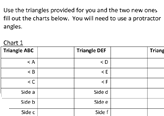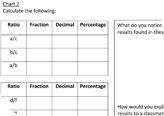Andy's Material: Trigonometry Exploration 1
Once the students had drawn their triangles, I gave them this sheet and asked the to fill it out. I did not supply them with any further instructions. Again the activity opened up many interesting conversations, such as: "What is the proper way to use protractors?", "How do you name triangles sides and angles?", and "How can we measure the length of the “slanted” side?" Many of these conversations could have taken place outside of this type of activity; however, in this context the students were seeking the information because they had a reason to, not because I decided that they should.
This is the activity that begins to reveal & reinforce for the students that corresponding sides of similar shapes have equivalent ratios. I found that my students think much better in percentages than fraction or decimals. Thus almost all of our initial conversations were in percentages. I believe that the students' experiences with percentages help them see the relationship between the shapes.
Download the images below with Rightclick -> Save As..., or get the pdf version here.
Grade Level: 10
Content:
Mathematical Processes:
Copyright © 2009 Elaine Simmt

